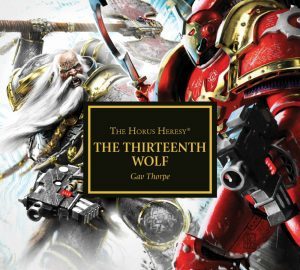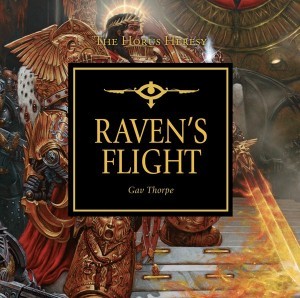Top Tips for Creating an Audio Drama
 With my latest Black Library audio Asurmen: The Darker Road just released, it seems like a good time to talk a bit about what goes into writing an audio drama. More specifically, we can take a look at what makes a good audio drama different from a good prose short story.
With my latest Black Library audio Asurmen: The Darker Road just released, it seems like a good time to talk a bit about what goes into writing an audio drama. More specifically, we can take a look at what makes a good audio drama different from a good prose short story.
In form, the audio drama is similar to the short story. A typical BL audio drama like The Darker Road is about seventy minutes long, including intro, scene breaks, credits and such. This translates to about ten thousand words of a prose story, which is quite a lot of narrative you can fit in. So, structurally speaking, any advice or thoughts that apply to short stories can equally be applied to constructing the story for your audio drama.
It’s worth pointing out that by ‘audio drama’ I mean a specially scripted piece, performed by multiple actors with a soundtrack and sound effects, much like a radio play. This is not to be confused with an audio book, which is a prose story read out by a single narrator (even if they put on voices or there is incidental music).
First Draft Formatting
However, when we get to the task of putting finger to keyboard the task gets a bit different. Firstly, you’ll likely be writing to a script format. This is like most other scripts, and will vary slightly from recording studio to recording studio. The main reason for such formatting is to make the job easier for the actors, sound designers and editor.
My first piece of advice would be – don’t worry about formatting in your first draft. Break your text into narrator, dialogue, sound effects and such as directed by the publisher, but don’t worry at first about indents, bolding direction text, or any of that. You’ll be chopping bits about and rewriting enough that things will almost inevitably end up in the wrong style.
 Get the words right and then, before submission, go through the manuscript and apply the formatting as required. Have a look at these blog posts for the original script extracts, with sound directions etc, from The Darker Road, and The Thirteenth Wolf.
Get the words right and then, before submission, go through the manuscript and apply the formatting as required. Have a look at these blog posts for the original script extracts, with sound directions etc, from The Darker Road, and The Thirteenth Wolf.
More with Less
While prose is often described as a movie with infinite budget, audio dramas are not. In particular, actors quite rightly like to be paid for their work. This limitation means that you must create your story around only a few speaking characters. Sure, you can have a few ‘Third Ensign from the Left’ cameos and one-line parts that the actors will fill in, but in terms of major speaking roles, you are looking at three or four at best – six as a maximum. The Darker Road focussed on the action around Asurmen and a young(ish) Eldrad Ulthran and these two characters carry the majority of the dialogue.
Not only does the budget constrain the number of speaking roles, so does the absence of dialogue tags – the ‘he said’, ‘she exclaimed’ bits of prose that indicate who is speaking. Your script needs to allow the listener to keep track of who is doing and saying what, and a limited palette of voices helps with that instant identification – as does mentioning the character’s name in narration leading up to new instances of dialogue. This is particularly important when introducing a new voice into the mix. For example, from The Darker Road:
The seers turned as one and Shar-telion inclined her head in respect. Her eyes lingered on Asurmen, intrigue in their depths.
SHAR-TELION: Timely is the arrival of the Hand of Asuryan. Proof that the course of action we seek to undertake has merit. Is it not true that the Phoenix Lords arrive upon the eve of great moments?
Use the small cast as inspiration to weave a tight narrative around that handful of characters, pushing the characterisation and conflicts between them to carry the story.
Make the Sound Designers Work, Not The Narrator
It’ll come as no surprise that audio has one big strength over prose… sound! The atmosphere, incidental sound effects and music set a scene every bit as much as the words you pen for the narrator – more so in many cases.
Sometimes it is useful to explain a sound effect – like a door slamming, for instance, that might be misinterpreted by the listener. If that isn’t the case, let the sounds speak for themselves and use narration to add visual cues for the listener– the flash of bolters to go with the crack of rounds that they can actually hear, or the changing colours of the leaves above when the wind stirs them.
[ATMOS: an army of eldar warriors emerge from a warp-portal directly onto the surface of Hiron-athela; it is a strange, dead city, ruined by ancient devastation, and the sky rumbles strangely overhead with echoes of the calamity that struck here; there are fast moving infantry, heavy grav-tanks and lighter scouting jetbikes that wheel and circle]
We engage less of our brain when we are listening, and so absorb and parse verbal information differently to how we take in the written word. As a writer you should avoid long stretches of narration and if possible use a little character exposition instead. Have characters remark on things that are happening.
Eldrad pointed with his staff at the upper windows.
ELDRAD (helmet*): The sun is always in the same position. No matter how we forge across the forest, the direction of light never changes. Always from the right as we enter, casting exactly the same shadows.
*”helmet” is a sound direction referring to the distortion heard as Eldrad speaks through his helmet
Work Smart and Fast
An audio needs to be broken down into scenes like any story. Unlike prose, an audio needs to give actors and the listener little breaks quite frequently. Several short scenes with little jumps of time and location between them, or a scene broken down into continuing sequences with small pauses, work better than one that goes on for a long time. Not only is it harder for the actors, the listener’s attention will start to wander.
Get into the action of the scene as quickly as possible – In Media Res in writerly parlance – and then when its job is done, get out of there. With sparse but effective narration, good dialogue and pointed sound effects, you can tell a lot of story in a short space.
Always remember that your word count in an audio is a hard limit. The length of the piece has to be cut to fit the space – you don’t get to cram just one more minute on a CD… If you are used to putting in a 5,500 word story for a 5,000 word commission you need to be more disciplined. Lines will be cut, perhaps even parts or whole scenes removed if the recording comes in over time.
 (There is an entire scene from Raven’s Flight that takes place before Corax returns to the dropsite, which never made it into audio but can be read in the prose collected version in the Shadows of Treachery anthology.)
(There is an entire scene from Raven’s Flight that takes place before Corax returns to the dropsite, which never made it into audio but can be read in the prose collected version in the Shadows of Treachery anthology.)
As a writer you should make those decisions before it gets sent away, to ensure your golden one-liner doesn’t end up on the editor’s hard drive equivalent of the cutting room floor.
If you’re running out of space, then cut narration first. Make the dialogue work harder for its space.
The most important piece of advice is to enjoy yourself. Use the audio format to stretch the way you think about your stories. Think about soundscapes as much as characters, atmosphere as much as plotlines.
From a forthcoming audio…
SCENE 1: EXT. WITHIN THE BLACK LIBRARY– DAY
[ATMOS: An ever-present background cosmic chorus of half-heard sighs, chimes, whispers of forgotten lore and the scratching of terrible entities trying to break in]
If you have any questions about writing for audios, let me know in the comments.
But Asurmen: The Darker Road
**To make sure you don’t miss out on any blog posts, you can keep up-to-date with everything Gav by signing up to my monthly newsletter. As a bonus, every other month I randomly pick a newsletter subscriber to receive a free signed copy of one of my books.**
Please Feel Free to Share:










